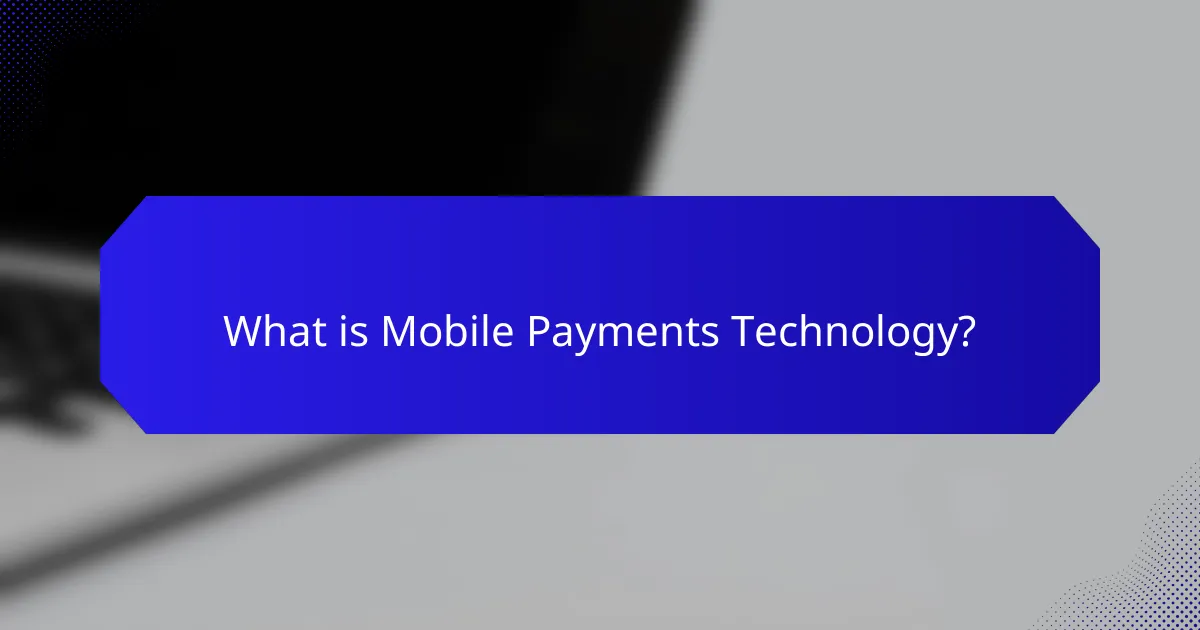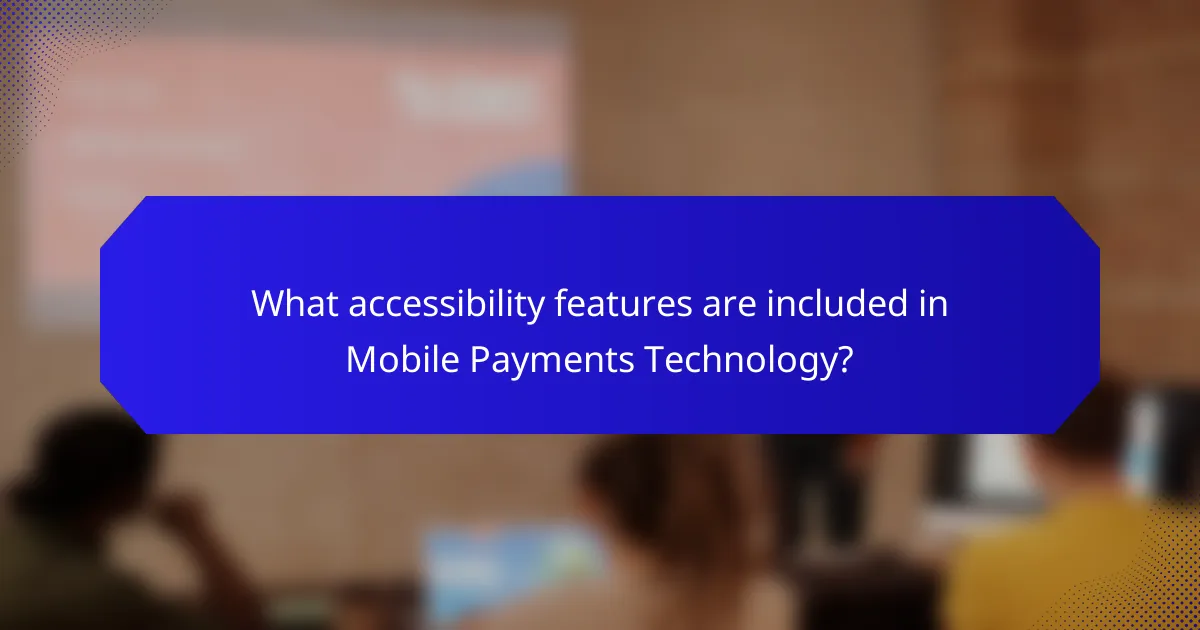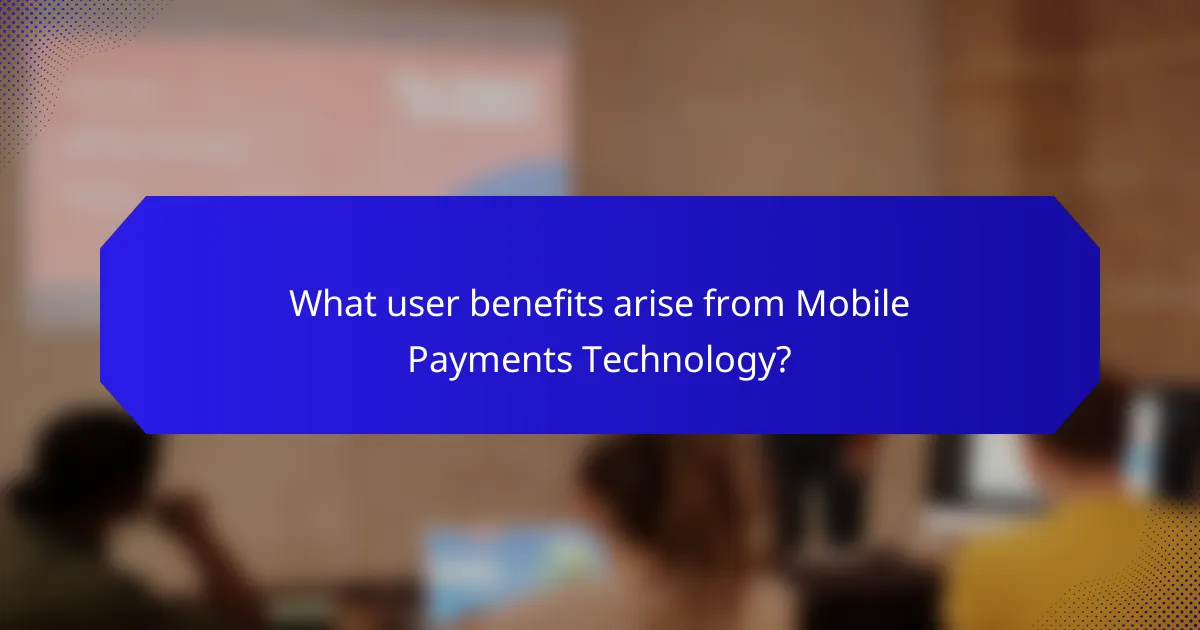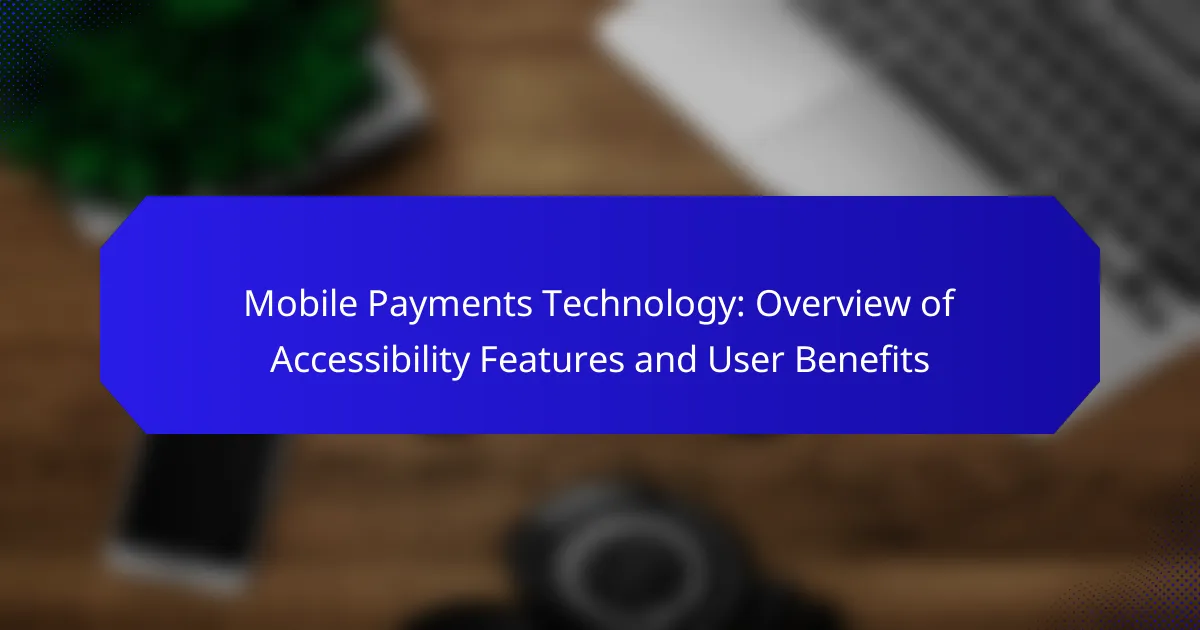Mobile payments technology enables financial transactions through mobile devices, allowing users to pay for goods and services using smartphones or tablets. This technology encompasses methods such as mobile wallets, contactless payments, and in-app purchases, projected to reach over $12 trillion by 2025. Key benefits include enhanced convenience, improved security through encryption and biometric authentication, and integrated loyalty programs. Accessibility features like voice recognition, screen readers, and customizable interfaces ensure usability for individuals with disabilities. The article provides a comprehensive overview of these features and the advantages of mobile payments, highlighting their role in facilitating transactions globally.

What is Mobile Payments Technology?
Mobile payments technology refers to the use of mobile devices to make financial transactions. This technology allows users to pay for goods and services via smartphones or tablets. It includes methods such as mobile wallets, contactless payments, and in-app purchases. According to Statista, the global mobile payment market is expected to reach over $12 trillion by 2025. Mobile payments enhance convenience and speed in transactions. They often utilize NFC (Near Field Communication) or QR codes for secure payments. Additionally, mobile payments can integrate loyalty programs and discounts directly within apps. This technology significantly improves accessibility for users, especially in remote areas.
How does Mobile Payments Technology function?
Mobile payments technology functions by enabling transactions through mobile devices. Users link their payment methods to mobile wallets or apps. These apps use near-field communication (NFC) or QR codes for transactions. NFC allows devices to communicate wirelessly at close range. QR codes can be scanned to initiate payments. The technology encrypts transaction data for security. This encryption protects sensitive information during the payment process. Mobile payments can be completed in seconds, enhancing user convenience. According to a report by Statista, mobile payment transactions are projected to reach $12 trillion by 2024, indicating rapid growth in this technology.
What are the key components of Mobile Payments Technology?
The key components of mobile payments technology include mobile wallets, Near Field Communication (NFC), and secure payment processing. Mobile wallets store payment information securely on devices. NFC enables contactless payments by allowing devices to communicate wirelessly over short distances. Secure payment processing ensures that transactions are encrypted and authenticated to protect user data. These components work together to facilitate fast and convenient transactions. According to a report by Statista, mobile payment transaction value is projected to reach over $1 trillion by 2024, highlighting the technology’s growing importance.
How do these components interact to facilitate transactions?
Mobile payment components interact through a series of processes that enable secure transactions. The primary components include the mobile device, payment application, payment gateway, and the financial institution. The mobile device initiates the transaction by sending payment information via the payment application. This application securely transmits the data to the payment gateway. The payment gateway processes the transaction by communicating with the financial institution. The financial institution verifies the transaction and confirms the availability of funds. Once validated, the transaction is completed, and confirmation is sent back through the gateway to the mobile device. This seamless interaction ensures quick and secure payment processing for users.
What are the different types of Mobile Payments Technology?
The different types of mobile payments technology include Near Field Communication (NFC), Mobile Wallets, and QR Code payments. NFC allows devices to communicate wirelessly over short distances. It is commonly used in contactless payment systems like Apple Pay and Google Pay. Mobile wallets store payment information securely on smartphones. They facilitate transactions through apps that can be linked to bank accounts or credit cards. QR Code payments involve scanning a code with a smartphone camera to complete a transaction. This method is widely adopted in markets like China, where apps like WeChat Pay and Alipay dominate. Each type enhances convenience and accessibility for users.
What is the difference between contactless and online mobile payments?
Contactless mobile payments allow users to make transactions by tapping their device near a point-of-sale terminal. This method uses near-field communication (NFC) technology. Online mobile payments require users to enter payment details through an app or website. This method often involves internet connectivity for processing transactions. Contactless payments are typically faster and more convenient for in-person purchases. In contrast, online payments are used for e-commerce transactions and may require additional steps like entering shipping information. Both methods aim to enhance payment efficiency, but they serve different contexts and user needs.
How do digital wallets compare to traditional payment methods?
Digital wallets offer faster and more convenient transactions compared to traditional payment methods. They allow users to make payments using smartphones or other digital devices. This eliminates the need for cash or physical cards. Digital wallets often support multiple payment options, including credit cards, debit cards, and bank transfers. Traditional methods usually involve manual entry of card information or handling cash.
Security is another key difference. Digital wallets use encryption and tokenization to protect user data. Traditional methods are more vulnerable to theft and fraud. According to a study by Juniper Research, digital wallet transactions are expected to reach $9.5 trillion globally by 2024. This indicates a significant shift in consumer preference towards digital wallets over traditional payment methods.

What accessibility features are included in Mobile Payments Technology?
Mobile payments technology includes several accessibility features to enhance user experience. These features often include voice recognition for hands-free transactions. Screen readers assist visually impaired users by reading payment information aloud. Haptic feedback provides tactile responses to confirm actions. Customizable font sizes help users with visual impairments read text easily. Simplified user interfaces cater to individuals with cognitive disabilities. Multilingual support ensures accessibility for non-native speakers. These features are designed to comply with accessibility standards, such as the Web Content Accessibility Guidelines (WCAG).
How do accessibility features enhance user experience?
Accessibility features enhance user experience by making mobile payments more inclusive and user-friendly. These features cater to individuals with diverse abilities, ensuring they can navigate payment systems effectively. For instance, voice commands allow visually impaired users to complete transactions without needing visual cues. Text-to-speech functionalities provide auditory guidance for users with reading difficulties. Additionally, customizable interfaces enable users to adjust settings according to their preferences, enhancing usability. Research shows that 15% of the global population experiences some form of disability, highlighting the need for accessible technology. By implementing these features, mobile payment systems can significantly improve overall user satisfaction and engagement.
What role do voice commands play in accessibility?
Voice commands enhance accessibility by allowing users to interact with devices hands-free. This feature is particularly beneficial for individuals with physical disabilities. Voice commands enable navigation through mobile payment systems without the need for touchscreens. They facilitate transactions by converting spoken language into commands. According to a study by the Pew Research Center, 46% of adults with disabilities find voice recognition technology helpful. This statistic highlights the significance of voice commands in improving user experience. Overall, voice commands play a crucial role in making mobile payments more accessible for diverse user groups.
How do visual aids support users with disabilities?
Visual aids support users with disabilities by enhancing comprehension and engagement. They provide alternative ways to access information. For users with visual impairments, high-contrast images and large fonts improve readability. For individuals with cognitive disabilities, simplified graphics can clarify complex concepts. Studies show that visual aids can increase retention of information by 65%. This is particularly important in mobile payments, where clear visuals can guide users through transactions. Visual aids also help reduce anxiety by providing familiar cues in new environments. Their effectiveness is backed by research indicating that 93% of communication is non-verbal. Therefore, integrating visual aids in mobile payment technology significantly enhances accessibility for users with disabilities.
What regulations influence accessibility in Mobile Payments Technology?
Regulations influencing accessibility in mobile payments technology include the Americans with Disabilities Act (ADA) and the Payment Card Industry Data Security Standard (PCI DSS). The ADA mandates accessible technology for individuals with disabilities, impacting mobile payment applications. Compliance ensures that mobile payment systems accommodate users with various needs. The PCI DSS outlines security requirements that indirectly affect accessibility by promoting user-friendly security measures. These regulations aim to create inclusive environments for all users.
How do these regulations impact design and functionality?
Regulations impact design and functionality by enforcing standards that enhance user accessibility. These standards require mobile payment systems to accommodate users with disabilities. Compliance with regulations often leads to features like voice commands and screen reader compatibility. Such features improve usability for individuals with visual impairments. Regulations also mandate clear labeling and easy navigation within payment apps. This ensures that all users can complete transactions efficiently. Studies show that accessible design increases user satisfaction and adoption rates. For instance, the Americans with Disabilities Act encourages inclusive design practices in technology.
What are the best practices for compliance with accessibility standards?
Best practices for compliance with accessibility standards include using semantic HTML to enhance screen reader compatibility. Ensure all images have descriptive alt text for visually impaired users. Provide keyboard navigation options for users who cannot use a mouse. Use sufficient color contrast between text and background to aid readability. Implement ARIA (Accessible Rich Internet Applications) roles and properties to improve user interaction. Regularly test applications with accessibility tools and real users with disabilities. Stay updated with WCAG (Web Content Accessibility Guidelines) to ensure ongoing compliance. These practices collectively enhance user experience and accessibility in mobile payment technologies.

What user benefits arise from Mobile Payments Technology?
Mobile payments technology offers several user benefits. It provides convenience by allowing users to make transactions quickly from their smartphones. This eliminates the need for physical cash or cards. Security is enhanced through encryption and biometric authentication. Many mobile payment systems also offer transaction tracking for better budget management. Users can enjoy rewards and discounts through loyalty programs integrated into mobile payment apps. Additionally, mobile payments facilitate international transactions with ease. The global mobile payments market is projected to reach $12.06 trillion by 2027, reflecting its growing adoption and user benefits.
How does Mobile Payments Technology improve convenience for users?
Mobile payments technology improves convenience for users by enabling quick and easy transactions. Users can make payments through their smartphones without needing cash or cards. This technology allows for contactless payments, reducing wait times at checkout. Mobile payments can be completed in seconds, enhancing the shopping experience. Moreover, users can store multiple payment methods within a single app. This eliminates the need to carry various cards. Studies show that mobile payments increase transaction speed by up to 50%. Additionally, many mobile payment systems offer features like transaction history and budgeting tools, further simplifying financial management.
What are the time-saving aspects of using mobile payments?
Mobile payments save time by streamlining transaction processes. Users can complete payments in seconds using their smartphones. This eliminates the need for cash handling or card swiping. Mobile payments often require just a quick scan or tap, which reduces checkout times. Many mobile payment platforms also allow for pre-authorization, speeding up the purchase process. According to a study by the Federal Reserve, mobile payments can reduce transaction times by up to 30%. This efficiency enhances customer experience and encourages repeat usage.
How does Mobile Payments Technology facilitate easier budgeting and tracking?
Mobile payments technology facilitates easier budgeting and tracking by providing real-time transaction data. Users can instantly view their spending through mobile apps. These apps often categorize expenses automatically. This categorization helps users identify spending patterns. Many mobile payment solutions also allow users to set budget limits. Alerts can notify users when they approach these limits. Additionally, some platforms generate spending reports over time. This data aids in making informed financial decisions.
What security features are integral to Mobile Payments Technology?
The integral security features of Mobile Payments Technology include encryption, tokenization, and biometric authentication. Encryption protects sensitive data during transmission. It ensures that information is unreadable to unauthorized parties. Tokenization replaces sensitive card details with unique identifiers. This reduces the risk of data breaches. Biometric authentication uses fingerprints or [censured] recognition for secure access. It adds an additional layer of security by verifying user identity. These features collectively enhance the safety of mobile transactions. According to a report by the Federal Reserve, these measures significantly reduce fraud and unauthorized access in mobile payments.
How do encryption and tokenization protect user data?
Encryption and tokenization protect user data by converting sensitive information into unreadable formats. Encryption uses algorithms to scramble data, making it inaccessible without a decryption key. This process ensures that even if data is intercepted, it remains secure. Tokenization replaces sensitive data with unique identifiers, or tokens. These tokens have no exploitable value, limiting the risk of data breaches. For example, when a credit card number is tokenized, the actual number is not stored in the system. Instead, a token is used for transactions, reducing exposure to potential theft. According to the 2021 Verizon Data Breach Investigations Report, 85% of data breaches involve human error, emphasizing the need for robust data protection methods like encryption and tokenization.
What measures are in place to prevent fraud and unauthorized transactions?
Mobile payments technology employs several measures to prevent fraud and unauthorized transactions. These measures include encryption, which secures data during transmission. Tokenization replaces sensitive information with unique identifiers. Multi-factor authentication requires users to verify their identity through multiple methods. Real-time transaction monitoring detects suspicious activity instantly. Biometric verification utilizes fingerprints or [censured] recognition for added security. Compliance with industry standards, such as PCI DSS, ensures robust security protocols. Regular software updates address vulnerabilities and enhance protection. These measures collectively safeguard users against fraud and unauthorized access.
What practical tips can users follow to maximize their experience with Mobile Payments Technology?
To maximize the experience with Mobile Payments Technology, users should enable biometric authentication. This adds an extra layer of security, making transactions safer. Users should also regularly update their mobile payment apps. Updates often include security enhancements and new features.
Utilizing contactless payment options can speed up transactions. Many merchants support this feature, allowing quick and convenient payments. Users should monitor their transaction history frequently. This practice helps identify unauthorized transactions early.
Setting spending limits within the app can prevent overspending. Many apps offer this feature to help users manage their finances. Users should also familiarize themselves with the app’s features. Knowing how to use all available tools enhances the overall experience.
Finally, using a secure internet connection is crucial. Public Wi-Fi can expose users to security risks during transactions. Following these tips can significantly improve the mobile payment experience.
Mobile Payments Technology encompasses the use of mobile devices for financial transactions, including methods like mobile wallets, NFC, and QR code payments. This article provides a comprehensive overview of the accessibility features integrated into mobile payments, such as voice recognition and customizable interfaces, aimed at enhancing user experience for individuals with disabilities. It also highlights the user benefits, including convenience, security, and budgeting tools, while discussing the integral security measures like encryption and tokenization that protect user data. Overall, the content emphasizes the growing importance of mobile payments in facilitating efficient and inclusive financial transactions.
